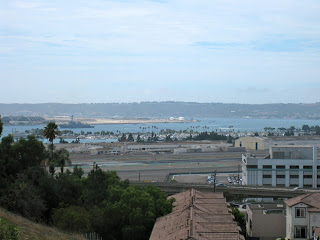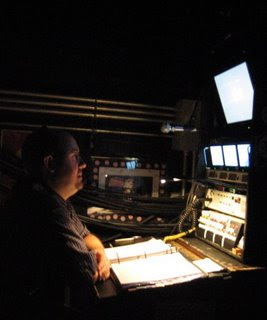After spending two months sitting down in Los Angeles, it was hard to get on the road again. Fortunately, our next move was a short one - sparing us the dramas of packing for an airplane and allowing me to drive a couple of hours with bulging bags that never would have made it across an airport scale. Roy and I drove down the California coast, stopping en route to visit the Mission at San Juan Capistrano.

I've visited several of California's 21 Spanish-era missions and found them intriguing, but the mission at San Juan Capistrano is justly known as the "crown jewel". Not only is the chapel itself beautiful, but the grounds are also extensive and well maintained. Many of the old structures have been restored and much of the archeological evidence on the grounds has been uncovered and is explained in the audio tour. Roy and I spent as much time as his load-in schedule would allow exploring.

Serra's Chapel - the only surviving church where Father Junipero Serra (the founder of CA's mission system) is known to have conducted a service.

Roy amid the ruins of the "Great Stone Church". The massive stone edifice was destroyed by an earthquake in 1812.

In the mission's courtyard
Roy and I rented a condo in the hills above downtown San Diego. It was a cute little place with a balcony looking out toward the water:

VFMHRW San Diego - looking across the airport to the navel air station and Point Loma beyond.
I really, really liked San Diego and I drug Roy out of the house every day to go exploring. On Wednesday, we drove out to the end of Point Loma. The Port of San Diego is sheltered by a thin hook of land that extends out from the north of San Diego and beds back to the south. At the tip of this hook is Point Loma. It was at Point Loma that the Portuguese navigator Juan Rodriguez Cabrillo, who was sailing for Spain, became the first European to come ashore in modern California in September of 1542. Today, much of the peninsula is controlled by the military, but the tip is a national monument.

The view from Point Loma back across the Naval Air Station toward downtown San Diego

The Old Point Loma Lighthouse - the light has since been relocated and automated, but the lighthouse has stood on this windy bluff separating the Pacific from San Diego Bay since 1855.

The ocean side of the peninsula is rocky and dramatic. It's also home to lots of tide pools, which were all under water when Roy and I visited.
Also on the ocean-side of the peninsula is the Ocean Beach neighborhood. While I dug most all of San Diego that I saw, Ocean Beach was my favorite neighborhood. It's the hippie and surfer hang-out. While still a part of laid-back San Diego, Ocean Beach feels like it's own small beach town. Roy and I happened to visit on Farmers' Market day and were greeted with all manner of baked goods, produce and flowers as well as people cooking up meals from every corner of the globe. We enjoyed ice cream sandwiches made with warm waffles as well as one of the best hamburgers I've ever eaten. The latter was created at Hodad's. It's a burger dive in the best sense of the term - decorated with surfing knick-nacks and even the front of a VW Minibus. The house specialty is a bacon cheeseburger made with a thin patty of chopped bacon that insures that there's bacon-y goodness in every bite. I'm sure it took months off my life, but I'm still thinking about how good it was and plotting a trip back to Ocean Beach...

With my warm waffle ice cream sandwich
The other gastronomic highlight of San Diego was the coffee cake at the Big Kitchen. I know, how good can coffee cake be? Go to the Big Kitchen and you will know. It was AMAZING. The rest of our breakfast was great, too - but our waiter was right to insist that we try the coffee cake.
On Thursday, I drug Roy and Lenny around the world famous San Diego Zoo. It took all day to make a quick trip around the zoo. We started with a bus orientation tour of the place that pointed out the highlights and then we set out on foot to get closer to the zoo's inhabitants. We left with aching feet, but having seen a wide variety of the world's fauna. It's the best sort of zoo: involved in conservation and breeding programs for many endangered species, the animals all appear engaged and healthy and the enclosures mimic the natural habitat of the animals.

Pandas always look more like people in panda costumes than wild animals to me...

Koalas spend 90% of their time sleeping - the other 10% of their life is spent eating.
They're so sleepy that their enclosure was hardly an enclosure at all. All that kept them in place was the fact that their eucalyptus was in the middle, there were no bars and hardly a fence; they don't stray too far from their food. (I can relate...)

Hilarious, unless you get peed on.
On Friday, Roy and I visited Old Town San Diego. Old Town is a State Historic Park that preserves and recreates the beginnings of San Diego from around 1821 through just after the creation of the State of California. It includes commercial buildings as well as residences such as the Casa de Estudillo. The Casa de Estudillo is an original 1827 adobe home built in the Spanish Colonial style with the rooms connected via an outdoor gallery, rather than interior halls, surrounding a large courtyard and garden.

The Casa de Estudillo
We also visited the original site of the Mission San Diego de Alcala. Founded in 1769, the San Diego mission was the first of California's missions and was located atop a hill overlooking the San Diego Bay. Unfortunately, there was no good source of fresh water, scurvy ran rampant through the early settlers and the natives resented the intrusion and attacked within a month of the mission's founding. In 1774, the mission was moved to its present location nearer the river. Today, the site of the original mission is home to the Father Junipero Serra Museum and the relocated mission is still an active Catholic Parish.

The Serra Museum

Mission San Diego de Alcala
Spamalot's home for the week was the San Diego Civic Theatre. Built in 1965 and run by the city as part of their city hall complex, the Civic Theatre was a perfectly pleasant place to be for a week. Downtown San Diego has plenty of restaurants and places to hang out after the show (San Diego's home to several colleges and there are plenty of college fun seekers out and about every night). The best part about the Civic Theatre, though, was the warm welcome they gave us. Between shows on Sunday, the theatre hosted a barbecue on the plaza for us! They grilled up hot dogs, hamburger and boca burgers and provided an array of salads and accompaniments. The genius of the barbecue, however, was not in the food; it was in the array of toys they provided:

Footballs were flying in all directions after dinner!

The hula hoops provided the best photo opportunities

Turned out that we had a few hula hooping champions among us!

Of course there was a cake!

The San Diego Civic Theatre
After the show on Sunday night, Roy and I drove out to Mission Beach for a visit to Belmont Park. Belmont Park is an ocean-side amusement park and home to the Giant Dipper. The Giant Dipper (no relation to the Giant Dipper in Santa Cruz) opened in 1925. The wooden coaster fell into disrepair and closed in 1976. In the '80's vagrants were camping under the rotting wooden structure and people were calling for it's destruction, but the coaster was designated a National Historic Landmark in 1987. The Giant Dipper re-opened in 1990 and is a great ride. With a 73' drop and 2,600' of track, the coaster is a great way to pass a minute and forty-five seconds!
San Diego has definitely been added to my list of places to return to - one week was only enough to scratch the surface. The climate was wonderful (it was 10 degrees cooler in San Diego than in Los Angeles). The city's setting against the ocean and surrounded by mountains was beautiful. The city is made up many distinct and interesting neighborhoods to explore. I look forward to a return visit to "America's Finest City"!
JV

































